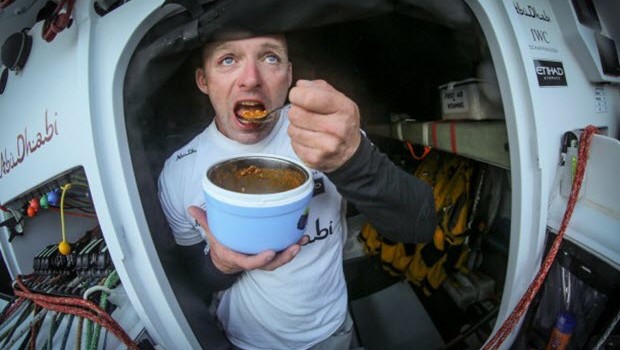Managing Nutrition to Maximize Performance
Published on July 23rd, 2014
Sports nutrition is a science now, but it hasn’t always been. Roll back the clock some 40 years to the earliest editions of the Volvo Ocean Race, and sailors could be seen boarding the boats overflowing with boxes of roast beef, baked beans, and beer.
But according to Dr Stefan Branth, who has been studying the impact of nutrition on the Volvo Ocean Race for nearly 20 years, that approach to nutrition served up severe consequences, with the lack of adequate food intake affecting performance considerably.
He noted in a study of the 1993-4 edition that a sustenance shortfall ‘caused a state of negative energy balance during all three legs, as weight loss occurred in almost all crew members’.
Nearly a decade later, in 2001-2, Branth returned to the race – studying sailors for five months, and noted that the long-term metabolic and mental stress they were under had major implications on their health.
With a lack of the right fuel going into their bodies, muscle tissue wasted to fat, and the crews began to display abdominal obesity. On top of that, insulin and heart rates increased – signs that their cells were desperately having to work harder, and break down other substances in order to create energy.
Today, diets are carefully tailored to suit their specific needs, and seeking to replenish around 6,000 calories each sailor in the Volvo Ocean Race burns per day. That’s nearly three times the typical amount.
To put that into perspective, it’s the equivalent of about a dozen rump steaks, 35 jacket potatoes, or 78 hard-boiled eggs.
But it’s not just about stacking up the calories like syrup-laden pancakes; it’s also about managing the weight of the food. Making them lighter by sucking the moisture out and freeze-drying, or stacking them heavy at certain points of the boat for better balance, contributes to the performance of the boat.
Freeze-dried dishes such as Spaghetti Bolognese, Chili Con Carne and Chicken Curry are featured menu items, re-activated using desalinated sea water, and they are backed up with protein shakes and power bars.
You won’t find customers queuing to eat at this restaurant, but with 6 of the 9 legs between 4600 and 6700 nm, the health of the sailors can be maintained with science and modern technology.
Background: The 2014-15 Volvo Ocean Race starts October 4 and will take the fleet to 11 cities in 11 countries – Spain, South Africa, United Arab Emirates, China, New Zealand, Brazil, United States, Portugal, France, The Netherlands, and Sweden – and will require the teams to cover 38,739 nautical miles over nearly nine months. It will be the first edition using the new one design Volvo Ocean 65 racing boats. Race website: http://www.volvooceanrace.com/en/home.html









 We’ll keep your information safe.
We’ll keep your information safe.